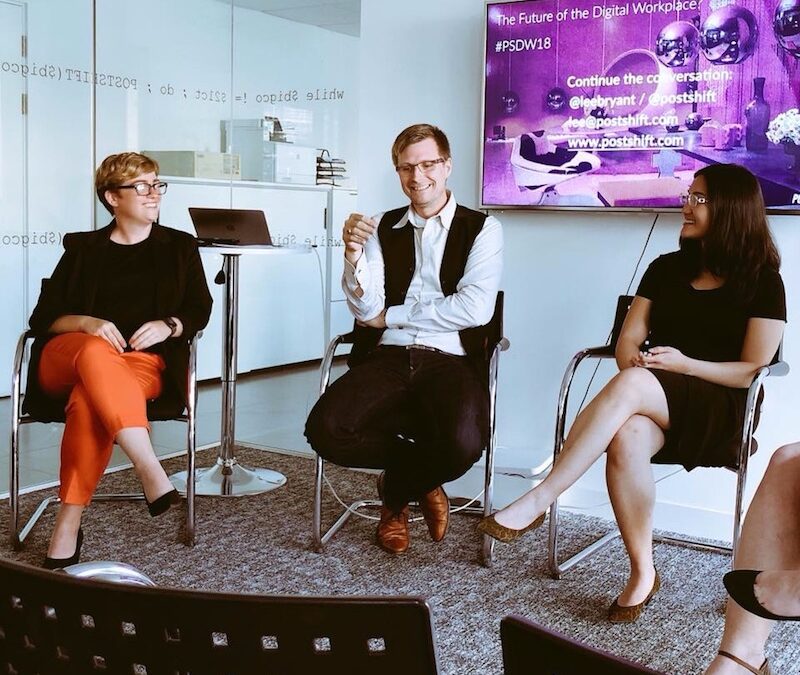- Katherine Carter, who has been involved in Grant Thornton’s digital workplace development since the early days, and who has recently played a lead role in transitioning from Jive to Office 365 (client).
- Jamie Tolentino-Deludet from Investec Asset Management, who is closely involved in the development of a digital workplace within the marketing function (client).
- Sharon O’Dea, an independent digital workplace consultant, formerly a practitioner at Standard Chartered Bank.
- Harald Schirmer, an experienced HR change agent who is running a major Office 365 roll-out at Continental, and a pioneer of the digital guides concept (client).
(You can find a summary of my introductory remarks here)
Key points
Recognising that the development of the digital workplace has proved slower than we originally hoped, what ideas did the panel of practitioners have for accelerating this process?…
We thought social would save us from the era of centralised comms and IT: but in reality what we got was Sharepoint 🤷🏼♀️ #PSDW18
— Postshift (@Postshift) July 5, 2018
… and where do they think the digital workplace is headed?
Final panel Q: What’s the future for the digital workplace? @sharonodea and @kat_carter think that most of our general day-to-day tasks can be automated by bots, @jamietolentino agrees, it leaves people free to do the real value-add! #PSDW18
— Postshift (@Postshift) July 5, 2018
Skills, Confidence and Change
Are people just afraid of change and trying new ways of working?…
Our own @CerysHearsey is moderating and kicks us off with asking what the big challenges are ahead for the digital workplace? @kat_carter thinks it’s people not wanting to change, afraid of trying new tools 😨 #PSDW18
— Postshift (@Postshift) July 5, 2018
… or is there a deeper problem with digital skills and confidence in our organisations?
One of the major problems: people are trained to call for support at work. #LearnedHelplessness #PSDW18 pic.twitter.com/KoHs9NJyUa
— Alexander Kluge (@alecmcint) July 5, 2018
Are people really ready and willing to adopt new ways of working?
The most requests recieved from internal people during their O365 digital workplace rollout is “can you make the new tool fit my old work style?” @haraldschirmer tells them no, you need to learn a new work style! ☝🏼 #PSDW18
— Postshift (@Postshift) July 5, 2018
Do we have the kind of culture that promotes experimentation and provides the psychological safety needed to allow people to self-organise and self-manage more of their work?
Trust and accountability needed to build the capabilities to they the best out of digital workplace tools says @CerysHearsey. @sharonodea says allowing self-organisation and experimentation without fear of failure. #PSDW18
— Postshift (@Postshift) July 5, 2018
Why are engineering-led firms so apparently reluctant to apply their own hypothesis- and data-driven philosophy to new ways of working and organisational improvement?
Engineering organisations find it hard to overcome fear of failure says @haraldschirmer – but @sharonodea makes the point that engineering skills are all about forming hypothesis and continually testing, we should leverage this. #PSDW18
— Postshift (@Postshift) July 5, 2018
Digital Leaders and Digital Guides
What role should leaders play in encouraging action and acting as exemplars for the use of digital tools?
What’s been the most effective convincer to get leadership buy-in? asks @CerysHearsey. @sharonodea says get leaders to use them themselves – to show benefit of being more visible and accessible, and take away their fear around that #PSDW18
— Postshift (@Postshift) July 5, 2018
How can digital guides accelerate change and provide the kind of digital leadership that is lacking at the top of most organisations?
We can build a new generation of digital leaders through implementing guide networks. @haraldschirmer is using this approach, and is seeing new traits such as curiosity emerge as key capabilities #PSDW18
— Postshift (@Postshift) July 5, 2018
@haraldschirmer is sharing ideas and insides into #digital #leadership – "there are million of stars out there already" #PSDW18 pic.twitter.com/pp1BybLMVu
— AnjaLo (@AnjaLommatzsch) July 5, 2018
Digital Tools and Platforms
What has been the impact of poorly integrated tools, and how has the arrival of Slack and other tools established a higher standard for integrating various apps to create a better personal experience? Have IT departments finally got the message that a diverse toolset is what employees need, not just one tool to rule them all?
Gradually we’re getting to a more diverse digital workplace with several tools rather than single centralised monoliths – but we risk creating fragmentation unless we can integrate tools better (Does O365 even integrate with itself? – lolz from @leebryant) #PSDW18
— Postshift (@Postshift) July 5, 2018
Or, as some consultants argue, are the tools themselves irrelevant?
Again: stop the tool discussion. You can solve tasks and become a master even with a mediocre tool – it’s about people, not the introduction of a better tool #PSDW18 pic.twitter.com/MP9WswVvv0
— Alexander Kluge (@alecmcint) July 5, 2018
It is interesting that this last tweet was one of the most re-tweeted by people following the event remotely, despite the nuanced discussion about tools, technology and culture taking place in the room. Yes, “it’s about people,” (that statement is little more than a platitude) but no cultural intervention can create a digital workplace or an organisational system fit for the digital age on its own.
We need more people who understand both technology architecture, tools and the cultural and behavioural side of the equation, but we also should not let the management of our organisations off the hook by ignoring the hard work of structural change, however tough that may be to sell. All my experience of younger and digitally confident employees in large organisations suggests they are ready and able to work in new and better ways, but the system and its work structures are what hold them back. We need better tools, better technology infrastructure generally, and then we need to ask what new (human) affordances they make possible – that, for me, is a key driver of digital transformation.

